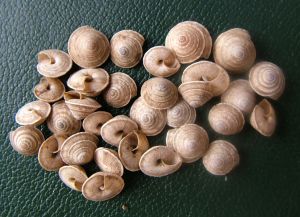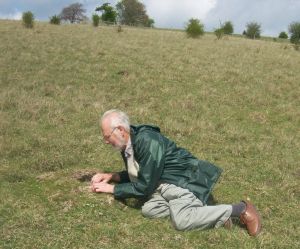|
It was 6 May 1950 and I was taking part in a field meeting, led by Arthur G. Davis and organised by the Conchological Society (Davis, 1950). I was eighteen years old and had been a member of the Society for only a fortnight. The venue was a grassy slope at White Hill, Chaldon, in Surrey. On that day I was one of a small party eager to re-examine the colony of a snail that had been discovered there almost exactly nineteen years earlier (Wilkins, 1931). The snail in question was Trochoidea elegans, a species recorded from only a few sites in the south-eastern corner of England. A recent, accidental import from Europe, it has a conical shell, flat sided and sharply keeled at the periphery. As a newcomer to the study of molluscs, I had never seen, much less collected this distinctive species. Vaguely I remember there had been some light rain that May morning and this could explain why the road at the base of the grassy slope was alive with dozens of Helix pomatia. I had never seen live examples before and was impressed by their size and weight. Among the shells of it I preserved and still have is one with a pure white shell. My day had started auspiciously. We now looked for T. elegans. Soon we each had many specimens (figure 1). They were crawling about in the grass, as were we. Clearly the colony was in good shape. For me, finding a noteworthy snail like this on my very first collecting excursion was a joy. One of the small group of snailers was slightly built and serious looking, but friendly. Curiously, he wore a glove on his left hand. I remember little more of my first meeting with him and only later did I learn that I had been collecting snails with Alex Comfort (figure 2). Like me, he was eighteen when he joined the Conchological Society, in 1938. Having read Natural Sciences at Cambridge, he trained in medicine at the London Hospital. Early in his chequered career he studied the biochemistry of shell pigments, publishing several authoritative articles on the subject (Comfort, 1950a & 1951). The ageing process also interested him and he published a valuable review of the life-spans and senescence of molluscs (Comfort, 1957). Other articles of his on molluscs, mostly about British species, appeared sporadically in the Journal of Conchology and elsewhere. After 1960, however, he published little more, if anything, on them. By that time he was already preoccupied with the subject that would ultimately make him famous and wealthy: sex. Born in 1920, Alex Comfort was a precocious and prolific author of novels, plays, poems, and works of non-fiction dealing with subjects as diverse as gerontology and quantum physics. A pacifist and anarchist, he was prepared to speak his mind and was no stranger to controversy. In 1943, for instance, he published some verses pouring scorn on the war effort and attacking Winston Churchill, among others. These verses drew a poetic response from an outraged George Orwell (who, nevertheless, became rather friendly with him subsequently). Many years later, Comfort resolved to throw new light on an old, similarly controversial topic. From the time he was at the London Hospital he had boldly tackled the tricky subject of human sexual behaviour, in a series of books. This eventually led to him advocating - and often practising - sex as a universal panacea. Finally, in 1973, he acquired notoriety and a healthy bank balance with his runaway bestseller, The Joy of Sex. A less provocative sequel, The New Joy of Sex, followed in 1991. He died, a celebrity of international status, in March 2000. Predictably, his death was widely reported. But what of T. elegans? May it, too, have died a death? Accompanied by my good friend, Tom Walker, I decided to find out. On 25th April 2010, having witnessed the coldest winter for many years, we visited Chaldon, sixty years after my first visit there (figures 3 & 6). It was a fine day and we were optimistic, although this time the road below the grassy slope of White Hill was not alive with H. pomatia. The situation changed dramatically as we meandered over the slope. This noble gastropod seemed to be everywhere. The pallid bodies of dozens of specimens were conspicuous on the grass, as were several discarded, white epiphragms. Most, if not all of them, may have come out of hibernation that very day. But where was Trochoidea? For an hour or more we searched unsuccessfully for it, on and under the grass, under fallen tree leaves and among rabbit scratchings. Then Tom found one, on bare soil under a thorn bush (figure 4) . Encouraged by this we extended our search and were rewarded by a few more examples each, but empty shells only. We never did find a living example. T. elegans is not used to prolonged cold conditions in southern Europe, where it originated, and we were left wondering if it still survives at Chaldon. Mission accomplished, we returned to the waiting car. Walking along the delightfully named Springbottom Lane, we noticed some small, brownish snails on a brick wall (figure 5). They were mostly immature examples of Hygromia cinctella, another recent import. Its shell, too, is conical, more or less flat sided and sharply keeled at the periphery. This snail was certainly unknown at Chaldon sixty years earlier. The first discovery of it on British soil was made - by Alex Comfort no less - in April 1950. Less than a month before I met him, he had discovered it in the Paignton area of Devon (Comfort, 1950b). Perhaps I should explain why he wore just the one glove. In 1997 I wrote to ask him if he remembered meeting me at Chaldon. At the same time I asked if he would kindly sign a copy of Elegies, a book of his poems I had acquired. In a badly typed letter, dated 18 February 1997, he replied: ‘I can’t sign anything – I’ve lost my right hand in a stroke and my left years ago in a firework explosion – this is a left thumb production, and my left thumb writing is a bit of a struggle. It also explains why this is such a rudely short note, as well as one or two mistypings, but I’m sure you understand. Every good wish – yes indeed, I recall collecting with you. Sincerely, Alex Comfort’ Long before he fell madly in love with sex he had had a passion for the world of molluscs. His contributions to the literature of that world were numerous, varied and carefully written. Alas, they were considered inconsequential, or were simply overlooked, by obituarists interested only in The Joy of Sex, which he had dashed off in a fortnight. Vainly, we look for notices of his demise and his achievements in specialist publications, such as the Journal of Conchology. Apparently his fame in one sphere had obscured his industry in another. Drawing attention to him now, in an article about a once favourite interest of his, may show that he should be remembered for more than a sensational sex manual. Certainly he would have liked to be remembered for more than that. I recall a day at Chaldon, sixty years ago, when he was on his knees, brushing aside the grass with a gloved hand, eagerly looking for some distinctive snails. On that day Alex Comfort surely knew the real meaning of joy. References Comfort, A. 1950b. Hygromia cinctella (Draparnaud) in England. J. Conchol. 23: 99-100. Comfort, A. 1950a. Biochemistry of molluscan shell pigments. Proc. malac. Soc. Lond. 28: 79-85. Comfort, A. 1951. Observations on the shell pigments of land pulmonates. Proc. malac. Soc. Lond. 29: 35-43. Comfort, A. 1957. The duration of life in molluscs. Proc. malac. Soc. Lond. 32: 219-241. Davis, A. G. 1951. [Notice of a field meeting to Chaldon, Surrey, 6 May 1950]. J. Conchol.23: 167. Wilkins, G. L. 1931. Trochula elegans Gmel. In Surrey. J. Conchol. 19: 147. |
figure 1: Shells of Trochoidea elegans found living at White Hill, Chaldon, by the author, 6 May 1950.
figure 2: Alex Comfort (based on a photograph)
figure 3: The author looking for T. elegans in a rabbit scratching. (photo: Tom Walker) figure 4: A long-dead T. elegans on bare soil. (photo:Tom Walker)
figure 5: Live Hygromia cinctella as seen on a wall at Springbottom Lane, Chaldon.
|
Comfort and joy among the snails of Chaldon
Issue
24
Page
12




